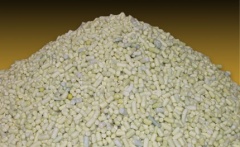Xanthates
| Infobox on Xanthates | |
|---|---|
| Example of Xanthates |  |
| Facts | |
| Origin | - |
| Stowage factor (in m3/t) | - |
| Humidity / moisture | - |
| Ventilation | - |
| Risk factors | See text |
Xanthates
Description / Application
Xanthate is a salt (usually potassium or sodium) of a xanthic acid. It is available as pelletized solids, having a pungent odour, soluble in water. Examples are potassium amyl xanthate, potassium ethyl Xanthate, sodium isobutyl xanthate, sodium isopropyl xanthate.
Most xanthate salts are yellow. These organosulfur compounds are important in two areas, the production of cellophane and related polymers from cellulose and secondly in mining for the extraction of certain ores. They are also versatile intermediates in organic synthesis. Xanthates also refer to esters of xanthic acid.
Xanthate salts are produced by the reaction of an alcohol with sodium or Potassium Hydroxide and carbon disulphide. The reaction involves the attack of the alkoxide salt. For example, sodium ethoxide gives sodium ethyl xanthate. Virtually any alcohol can be used in this reaction. Technical grade xanthate salts are usually of 90–95% purity. Impurities include alkali-metal sulfide, sulfate, trithiocarbonates, thiosulfate, sulfite, or carbonate as well as residual raw material such as alcohol and alkali hydroxide. These salts are available commercially as powder, granules, flakes, sticks, and solutions are available. China is a major exporter of granules.
Use: Collector agents in the flotation of sulphide minerals, metallic elements such as copper, silver, gold, and some oxidized minerals of lead and copper.
Shipment / Storage / Risk factors
To be given a cool stow away from ship's accommodations, foodstuffs and allied products.
On contact with moisture, evolves highly flammable vapours such as carbon disulphide. When confined, can cause an explosion due to the wide explosive limits of the vapours. Finely divided dust forms explosive mixtures in air. Care should be taken when opening cargo transport units in case carbon disulphide vapours are present.
For overseas carriage aspects of Chemicals, the readers are recommended to acquire or have access to a good chemical dictionary, and a copy of the International Maritime Dangerous Goods (IMDG) Code, issued by the International Maritime Organisation. Also consult the applicable MSDS sheet.
See also: http://www.chemicalland21.com/listaz01.htm#T











